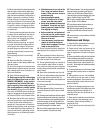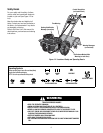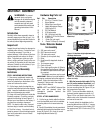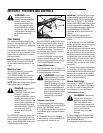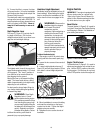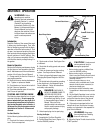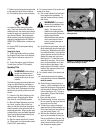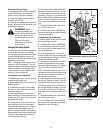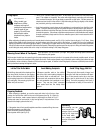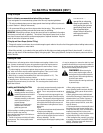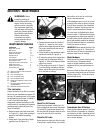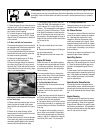
12
7. Choke or prime the engine as instructed
in the separate Engine Owner’s Manual.
8. Check behind you to avoid contacting
any obstacles when pulling the starter
rope. Place one hand on the fuel tank to
stabilize the unit and use the recoil starter
to start the engine as instructed in the En-
gine Owner’s Manual. When the engine
starts, gradually move the choke lever (on
engines so equipped) to the NO CHOKE,
CHOKE OFF or RUN position, whichever ap-
plies.
9. Use the FAST throttle speed setting
when tilling.
Stopping the Engine
1. To stop the wheels and tines, release
the Forward Clutch levers or the Reverse
Clutch Control (whichever control is in
use).
2. To stop the engine, move the Engine
Throttle Lever into the STOP position.
Operating Tiller
WARNING: Before tilling,
contact your telephone and
utilities company to inquire if
underground ines are on your
property.
The following pages provide guidelines to
using your tiller effectively and safely in
various gardening applications. Be sure to
read Tilling Tips & Techniques in this Sec-
tion before you actually put the tines into
the soil.
1. Follow the Pre-Start Checklist on the
previous page. Be sure that the Wheel
Gear Lever is in the ENGAGE position.
2. Move the Depth Regulator Lever into
the “travel” position (lever all the way
down) so that the tines clear the ground.
Use this position when practicing with or
transporting the tiller. When you are ready
to begin tilling, move the Depth Regulator
Lever into the desired depth setting (see
Tilling Tips & Techniques).
3. Start the engine and allow it to warm
up. When warm, move the throttle control
into the FAST speed setting.
4. For forward motion of the wheels and
power to the tines:
(a) Pull up and hold the Forward Clutch
levers against the handlebars. To
stop the wheels and tines, release
both levers.
WARNING: Do not push
down on the handlebars to try
to make the tiller till more
deeply. This prevents the
wheels from holding the tiller
back and can allow the tines to
rapidly propel the tiller
backward toward the operator,
which could result in loss of
control, property damage, or
personal injury.
(b) As the tiller moves forward, relax and
let the wheels pull the unit along while
the tines dig. Walk behind and a little
to one side of the tiller. Use a light but
secure grip with one hand on the han-
dlebars, but keep your arm loose.
See Figure 4-2. Let the tiller move
ahead at its own pace. Do not push
down on the handlebars to try and
force the tiller to dig deeper – this
takes weight off the wheels, reduces
traction, and causes the tines to try
and propel the tiller.
5. For reverse motion of the wheels and
tines:
(a) Look behind and exercise caution
when operating in reverse. Do not till
while in reverse.
(b) Stop all forward motion before re-
versing. Lift the handlebars with one
hand until the tines are off the ground
and then pull the Reverse Clutch con-
trol out (see Figure 4-3). To stop re-
verse motion, let go of the Reverse
Clutch Control.
6. To turn the tiller around:
(a) Practice turning in a level, open area.
Be very careful to keep your feet and
legs away from the tines.
(b) To start a turn, reduce the engine
speed and then lift the handlebars un-
til the engine and tines are balanced
over the wheels (Figure 4-4).
(c) With the tiller balanced, push side-
ways on the handlebar to move the
tiller in the direction of the turn (Fig-
ure 4-5). After completing the turn,
slowly lower the tines into the soil
and increase the engine speed.
Figure 4-2: Use one hand to guide tiller when
moving forward.
Figure 4-3: Raise tines off ground and look
behind when moving in reverse.
Figure 4-4: Find balance point before turning.
Figure 4-5



